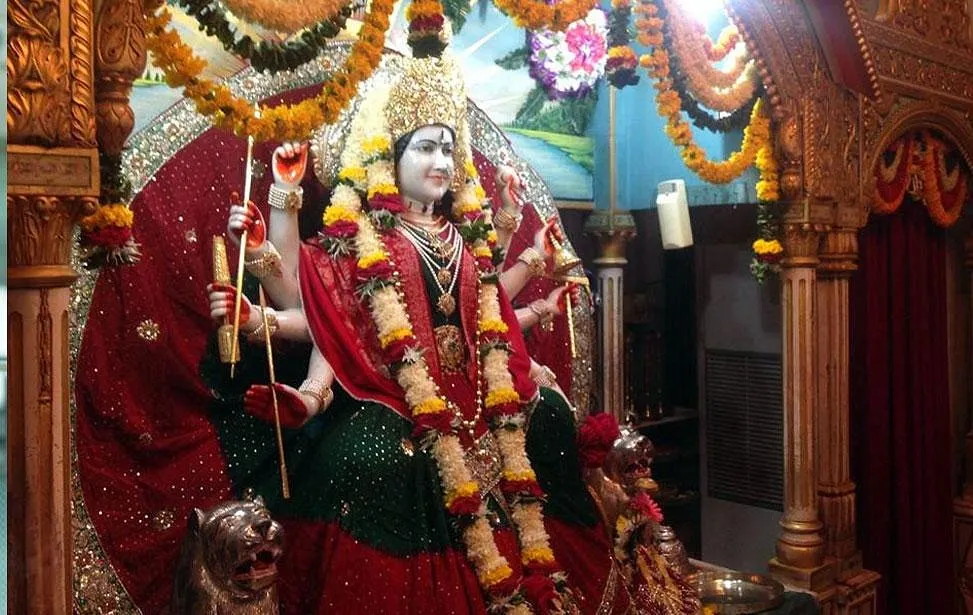Ambaji Temple Darshan Time
Ambaji temple is a very important temple and thousands of devotee’s flock to see it every week. Due to its good location and proximity from major commercial and tourist destinations like Palampur, Mount Abu, Ahmedabad and Kaliyadra travelling to the Ambaji temple is not a problem. If you do not know the correct timings of the Ambaji Temple Darshan Time. Then it is a hassle to stand waiting in front of the premises till the gates are throw open for visitors. It is better to come in the early slot of Darshan as the crowd increases as the day passes by. If you have an interest in attending the Purnima festivities in Ambaji then you will have to choose a full moon evening for the same. On the day of Badarvi Poornima, a grand fair is held in front of the temple and many travel from far to see it.
Darshan, Aarti
The temple opens for Darshan of Amba Maa Yantra every morning and remains open for a few hours. However, the exact timings depend on any particular Annakoot day according to the holy calendar. Every day at 6.00 A.M morning Aarti is carried on at the temple.
Summers the temple follows the following schedule
- The morning Darshan timing is between 7.00 A.M to 10.45 Α.Μ
- The Afternoon Darshan timing is between 12.30 P.M to 16.30 P.M
- The evening Darshan timing is between 19.30 P.M to 21.15 P.M
Monsoons the temple follows the following schedule
- The morning Darshan timing is between 7.00 A.M to 11.30 Α.Μ
- The Afternoon Darshan timing is between 12.30 P.M to 16.30 P.M
- The evening Darshan timing is between 19.00 P.M to 21.00 P.M
Winters the temple follows the following schedule
- The morning Darshan timing is between 7.00 A.M to 11.30 Α.Μ
- The Afternoon Darshan timing is between 12.30 P.M to 16.00 P.M
- The evening Darshan timing is between 18.00 P.M to 20.30 P.M

Ambaji Temple Ambaji Facts
| City | Ambaji |
| State | Gujarat |
| Region | West |
| Country | India |
| Deities | Gujarat |
| Significance | The shrine of Shri Amba is regarded as a revered shrine by the Shakta Shaktism sect of Hinduism. It is believed that the Heart of Sati Devi has fallen here. |
| Live Darshan | Not Available |
| Entry Fees | Free Entry |
| Famous Pooja | Rajbhog Aarti & Sandhya Aarti |
| Dress Code | Any decent outfit |
| Festivals | Chaitra Navratri, Shravan Vad Amas, Aswin Sud Navratri |
| Address | Ta.Danta, Dist.B.k, Khodiyar Chowk, Ambaji, Gujarat 385110 |
| Pooja Tickets Availability | Free Pooja |
| Best Season To Visit | One can visit the temple at any season. |
| Temple Timings | Monday to Sunday |
| Darshan Tickets Booking | Free Darshan is available for all the devotees. |
Shakti peeth Based In Gujarat
India is home to 51 Shakti peeth which are spread across the country. One of these Shakti peeth is the Ambaji Mata temple located in Gujarat. This temple is held in high regard by the Hindu sect known as Shakta Shaktism and it is believed that it is here that Sita Devi’s hand fell. Let us find out about the history and significance of the Ambaji Temple.
Ambaji mata temple is located in the state of North Gujarat’s taluka district of Banaskantha, in the Aravalli Range in Gujarat, India. The temple is dedicated to Goddess Amba, also known as Ambaji, who is believed to be a manifestation of the Hindu goddess Durga. The temple is one of the 51 Shakti Peethas, considered the most sacred shrine in the Hindu religion.
Ambaji temple Gujarat

The Shri Amba’s shrine is held in very high regard by the Hindu sect known as Shakta Shaktism. It is thought that this is where Sati Devi’s heart fell.
There is no statue or picture of the Goddess in “Arasuri Ambaji’s” heavenly temple. The blessed “Shree Vishwa Yantra” is revered as the supreme deity.
The Yantra cannot be seen with the nake eye. The Yantra cannot be photographer under any circumstances. This Vishwa Yantra has ornaments and unique clothing that make it look like Goddess Ma Ambe.
Located on the slopes of Arasur Parvat in the Ambica woods, toward the southwest side of the old slopes of Arvalli, it is close to where the renowned Vedic river Saraswati begins.
History Of Ambaji temple
It is the main shrine of a deity ador from the pre-Vedic period. The Goddess is also know as Arasuri Amba, from the temple’s position in the Arasur hills, at the origin of the River at the southern extremity of the Aravali mountainous region. Among the 51 Shakti Peethas is Ambaji Mata Temple. It is a crucial Shakti Peeth in India.
The crimson flag flying atop the temple flutters in the breeze. Nagar Brahmins initially constructed the temple out of white marble with gold cones. Because the Mataji (another name for Ambaji) had prevented the addition of any other door, there is just one central entrance in the front and one little side door. Chachar Chowk surrounds the temple, an open plaza where ceremonial sacrifices known as havans occur.
Maa Amba’s brilliance makes her a cherished shrine among devotees of the Shaktism sect of Devout Hindus. Because Devi Sati’s heart fell here, this is a potent Shakti Peeth. Daksha Yaga Mythology has an intriguing narrative behind the acquisition of Shakti Peeth Status. Every Shakti Peeth had its establishment when a portion of Goddess Sati Devi’s body dropped into that location. According to the bards, Lord Shiva danced with Sati Devi’s corpse in dreadful fury and sadness, and her body split into 51 pieces. The Shakti Peeth has a significant tantric connection and a link to Batuk Bhairav.
Interesting facts about Ambaji temple
Balyaroop of Ma Ambe is worshipp in the morning while receiving Bal Bhog as a meal. Yauvanroop is honor with Rajbhog Pras in a gold thal in the evening, and Praudhroop is worshipp with Sayanbhog in the late evening.
The only place on earth where Ma Devi Ambe’s savari is continuously chang vahan is Amabji Temple. The following animals are use as Ma Devi Ambe’s Savari, Vahan, or rider.
Tiger on Sunday, Nandi on Monday, Lion on Tuesday, Aairavat on Wednesday, Garudjee on Thursday, Hans on Friday, and Elephant on Saturday.
Akhand Jyot, or Holy Light, has been in Chanchar Chowk for many years. In a similar vein, another Akhand Jyot is located on Gabbar Hill.
From Chanchar Chowk or Gabbar, devotees can observe the Jyoti in line in the evening.
Architecture
The temple’s inner sanctuary boasts silver-plated doors. The primary center of devotion is a gokh, or alcove, in the wall with an ancient marble engraving of the Viso Yantra, a Vedic book on sacred geometry. There is no goddess idol, maybe because the temple predates idol adoration, but the priests adorn the upper half of the gokh in a way that appears to be a goddess idol from a distance.
Also Read: Evolution of Apple MacBook: Apple Working on Foldable MacBook
Conclusion
The Ambaji Temple stands as a revered site deeply entrenched in Hindu mythology and spirituality. Situated amidst the scenic Aravalli Range in Gujarat, India, it holds significance as one of the 51 Shakti Peethas, symbolizing the divine feminine power. Devotees flock to this temple to pay homage to Goddess Amba, believed to be a manifestation of Durga. The temple’s unique feature lies in the absence of a physical idol, with devotion centered around the enigmatic Vishwa Yantra.
Rich in history and tradition, the temple hosts various rituals and festivities, drawing devotees from far and wide. Its architectural grandeur, coupled with spiritual ambiance, creates an atmosphere of profound reverence and devotion. The continuous ceremonial practices and the temple’s role in preserving ancient rituals underscore its enduring cultural importance. Thus, the Ambaji Temple stands not only as a place of worship but also as a testament to the enduring faith and cultural heritage of the region.









